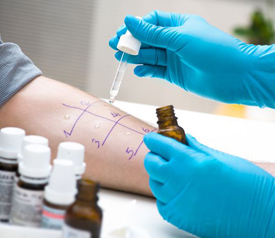
Determining the cause of tape sensitivity
Wound care recommendations generally focus on the wound bed and wound borders. However, healthcare professionals must also consider the healthy skin surrounding the wound. If patients develop tape sensitivity it may become difficult to secure the dressings that promote optimal wound care. When tape sensitivity occurs, healthcare professionals must quickly determine the cause and take steps when treating contact dermatitis.
The initial assessment can be revealing
Healthcare professionals should look for signs of tape sensitivity during dressing changes. Areas of healthy skin (i.e. skin not disrupted by the wound itself) may be erythematous, itchy and inflamed. Not all visible changes to the skin indicate tape sensitivity, however. An occlusive dressing that retains moisture may cause healthy skin to swell and look pink or pale. In this case, the skin should return to normal relatively quickly after the tape and dressing removed and the tissue “dries out.” Inflamed skin or dermatitis, on the other hand, generally takes longer to resolve.
Distinguishing between irritant and allergic contact dermatitis
Once contact dermatitis is suspected, it can be helpful to distinguish between irritant contact dermatitis and allergic contact dermatitis. In a recent article, we reviewed the similarities and differences between irritant and allergic contact dermatitis. Simply put, allergic contact dermatitis involves an immune response (either non-IgE- mediated or IgE-mediated) while contact dermatitis does not.
It can sometimes be difficult to distinguish between these two types of skin abnormalities from visual cues alone. Allergic contact dermatitis usually manifests as a skin rash and itching that occurs within 1 to 4 days of initial contact with the latex-containing product. Irritant contact dermatitis usually occurs more rapidly, often within a few hours. Skin redness and intense itching are strong indicators of allergic contact dermatitis. In contrast, irritant contact dermatitis often leaves the skin dry, scaly, cracking and feeling “tight.” Complicating matters, people with allergic contact dermatitis who are chronically exposed to latex develop dry, scaly, crusty skin over the areas of contact. Further muddying the issue is that blisters may appear in both allergic and irritant contact dermatitis. The blisters that occur in allergic contact dermatitis are large and tend to weep fluid, while those in irritant contact dermatitis are smaller and firmer. Unfortunately, there is no specific test for irritant contact dermatitis. Thus, the diagnosis of irritant contact dermatitis is either made from clinical history alone or when allergic contact dermatitis (usually from latex allergy) has been excluded.
Making the diagnosis of latex allergy
Latex allergy is now widely recognized among healthcare professionals and the lay community. The patient may know that she has a latex allergy, and simply asking her can solve the problem. Importantly, patients may become sensitive to latex without ever coming into contact with objects that obviously contain latex (e.g. latex gloves). Latex allergens are present in a remarkable number of household products. Likewise, patients with latex allergy may become cross-sensitized to certain fruits such as kiwi, avocado, banana, celery or even wheat. Asking about these food sensitivities may help support the diagnosis. Indeed, the American College of Allergy, Asthma, and Immunology has published “Guidelines for the Management of Latex Allergies and Safely Takes Use in Healthcare Facilities,” which includes a latex allergy diagnostic questionnaire that can help healthcare professional thoroughly evaluate for potential latex allergy.
Latex allergy can be definitively diagnosed through one or more clinical tests. Where available, patients may undergo latex-specific IgE antibody serology testing. These blood tests, such as ImmunoCAP or Immulite, test for IgE levels in the serum. If these blood tests are not available, skin prick testing is a safe alternative. Because latex allergy can be severe in some patients, causing anaphylaxis and the risk of death, provocation testing for latex allergy is reserved for only rare and particular circumstances.
Treating tape sensitivity
Fortunately, the treatments for both are mostly the same. The first and most important step is to remove the tape that is causing the problem and avoid it in the future. The area should be cleaned with warm (not hot) water and a mild soap to remove remaining irritants and/or allergens. Topical corticosteroids can be used to reduce inflammation. Likewise, emollients and moisturizers can help soothe the skin, retain moisture, and soften the stratum corneum, i.e., the topmost layer skin.
If latex allergy is suspected or diagnosis is pending, healthcare professionals should use a latex-free tape. Moreover, the tape should be non-reactive to help minimize the risk of negative skin reactions. Hy-Tape is an excellent choice in this regard because it is a high-quality, latex-free, non-reactive medical tape. Perhaps just as importantly, Hy-Tape is occlusive, waterproof, and its zinc-based adhesive is soothing to inflamed, irritated skin. Thus, Hy-Tape helps retain moisture in the skin and may work synergistically with emollients and moisturizers to soothe and restore.
If you suspect you have tape sensitivity and may benefit from a latex-free, non-reactive medical tape, contact Hy-Tape for a free sample.

